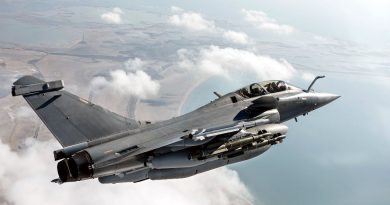
DSEI 2025 – MBDA unveils the latest member of its Spear family, the Spear Glide
Among a series of new effectors, at DSEI 2025 MBDA unveiled the Spear Glide, a new air-launched munition that exploits the work done on the Spear weapons, adding a lower-cost, mass-producible system to its portfolio
The concept of a gliding weapon derived from the Spear had been around for some time, but in the last 18 months the European missile company decided to accelerate the work on what is now known as Spear Glide, to meet the requirement of a medium-range utility strike weapon. “After the initial days of a conflict, where higher-end weapons are used, reducing the effectiveness of enemy air defences, the Spear Glide will be able to complete the destruction,” a company source declared.
Compared to the Spear, the Spear Glide lacks the turbojet and the fuel system, which allows to add a full-calibre kinetic penetrator designed to engage soft and moderately hardened fixed sites, such as hardened bunkers and command posts, as well as slow moving mobile targets. The penetrator exploits kinetic energy and contains an undisclosed amount of high explosive, it’s safe and arming device being taken from the MBDA portfolio.
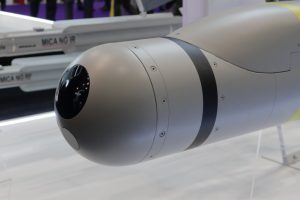
Not only, the RF seeker of the Spear has been replaced by an electro-optic/infrared seeker that allows to do image-based navigation and terminal guidance even in GNSS-denied scenarios, EDR On-Line understanding that the seeker exploits heavily the work done on the Crossbow seeker. Two newly developed key algorithms are loaded in the processor, one dealing with image-based navigation, the second dealing with target identification. It is also being fitted with a SAL (Semi-Active Laser) seeker, which will allow to further increase accuracy when the target is illuminated by a third party designator, air- or land-based.
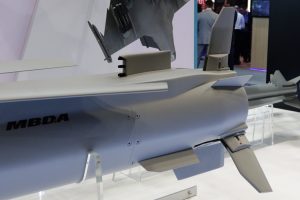
The Spear Glide was developed with three major priorities in mind. First, the ability to manufacture at rate, should the need arise, second the quick and smart integration on platforms to allow a quick entry into service, and finally the reduced cost. The first and last points come often together, as the use of commercial off-the-shelf components, which are however brought to the high performance level required by complex weapons exploiting advanced machine-learned algorithms, which were developed in cooperation with the UK Defence Science and Technology Laboratory (DSTL). “We did that in the last two-three years under frameworks such as the MCM ITP [1] and WSRF [2],” MBDA explained. Being a gliding weapon, its energy in the final stage of the flight is not comparable with that of a powered weapon, hence its manoeuvrability in that phase is relatively limited. However, being a lower cost weapon, MBDA considers that more than one will be used against a single target, considerably increasing kill probability.
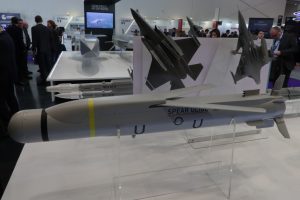
As for ease of integration, this is quite obvious especially on those platforms where the original Spear was already integrated. EDR On-Line understood that to integrate the Spear Glide a very limited work has to be done, the weapon also maintaining common logistic, handling and training systems, which contribute not only to speed up integration but also reduce ownership cost. In the design phase engineers were very careful in maintaining the mass balance, the centre of gravity and other physical characteristics as close as possible to those of the original Spear.
The Spear Glide is less than 2 metres long and has a mass under 100 kg, and exploits existing launchers such as the three-pack and four-pack designed for Spear. MBDA aims at the fourth-generation market, so aircraft such as the Eurofighter Typhoon, Saab Gripen, and KAI KF-21. That said, the company is close to certify an internal weapons-bay launcher for the F-35. No range indication was provided, as this depends much on release altitude and wind conditions. EDR On-Line understood the range should be comparable with that of competing systems, such as the GBU-53/B Storm Breaker and the Spice 250.
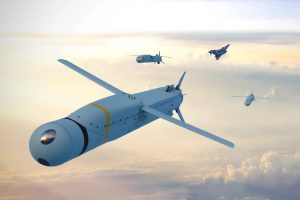
The Spear Glide was designed to be easy to produce, using traditional engineering methods rather than high end advanced weapons manufacturing, which not only allows mass production but also eases any potential transfer of technology to produce the weapon in customer’s nations. Some sub-components may even come from other countries, and should the customer decide for some national sub-components this could be done, at minimal certification costs.
The Spear Glide is now in full development, MBDA declaring that the new weapon is now a mature concept, the company being busy in testing the two new major subcomponents, the front end seeker and the warhead. Full development will be launched when a launch customer will appear, the company considering that Spear Glide will be available between two and a half, three years from contract signature.
Graphics courtesy MBDA, photos by P. Valpolini
[1] The Materials and Components for Missiles Innovation Technology Partnership scheme was launched to develop novel and exploitable technologies for next-generation missiles, capable to solve the capability challenges for future Anglo-French guided weapons.
[2] The Weapons Sector Research Framework enabled the UK Government to quickly and efficiently place contract for scientific research and technical research and development, accelerating the development of emerging and disruptive weapons technologies.



